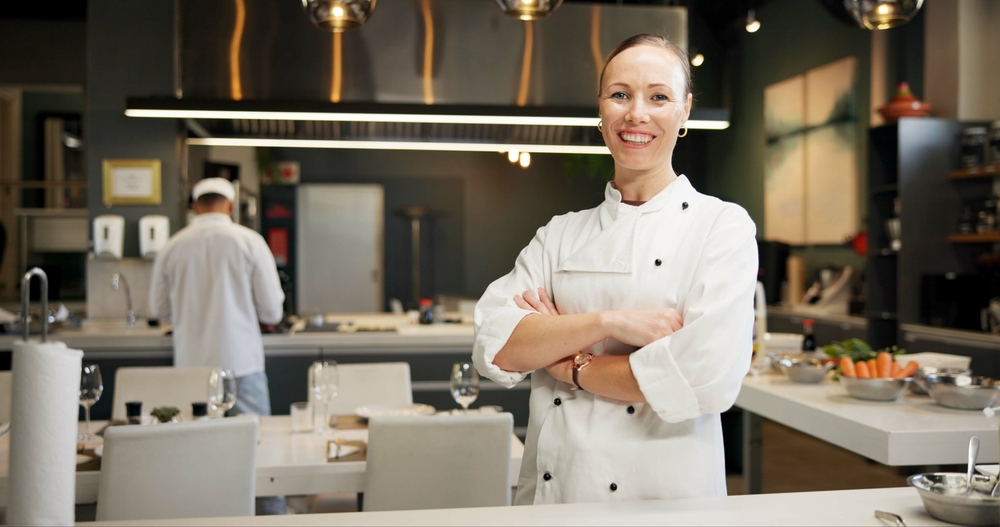Designing a commercial kitchen, whether you’re starting from scratch or giving an existing space a full makeover, is a challenging task. Business owners often face a myriad of decisions and questions throughout the process.
This blog post aims to address some of the most frequently asked questions that food service businesses have when undertaking a commercial kitchen design project.
From commercial kitchen layout to compliance, let’s get your questions answered.
Commercial Kitchen Design & Layout
1. What factors must be considered when designing the layout of a commercial kitchen?
When designing the layout of a commercial kitchen, several critical factors must be considered to ensure the space is efficient, compliant, and tailored to the operational needs of the business.
- Menu: It starts with understanding the menu, as the dishes you’re cooking dictate everything from the equipment you’ll need to how many people you can have on the line.
- Space Assessment: Next, you should make a realistic assessment of the space needed. Every single inch counts, including ceiling height, where the water and gas lines are, and how people and supplies will get in and out. This groundwork will guide you toward the right layout, whether that’s an assembly line, an island setup, or a classic galley kitchen.
- Type of business and industry: Beyond the physical space, you need to think about the type of business you’re running and the industry. A busy restaurant requires a different setup and needs than a small cafe. This means considering everything from your peak-hour rush to staffing levels.
- Budget. You need to have a clear and realistic budget. That has to cover not just the kitchen equipment itself but also installation, ventilation, fire suppression, and all the professional help you’ll need.
- Strategic zoning and workflow. You want your food to follow a logical path, from prepping to service areas. Strategic zoning is essential in the design of any commercial kitchen, as it creates a logical and efficient workflow that enhances safety, supports staff operations, and helps maintain hygiene standards. By dividing the kitchen into dedicated zones, such as food preparation area, cooking, service, and cleaning, you can streamline the processes and minimise the risk of cross-contamination.
- Of course, health and safety compliance is non-negotiable. You need to consider the current health and safety regulations for commercial kitchens and plan your layout accordingly. From keeping raw and cooked food areas separate to installing the right fire suppression and ventilation systems.
- Tech Integration: Plan for seamless integration of technology like Kitchen Display Systems (KDS) and smart appliances.
2. What is the hierarchy of a commercial kitchen?
The hierarchy of a commercial kitchen isn’t just about who’s in charge; it shapes how the space is laid out. The layout is designed to allow the kitchen staff to work independently on their tasks without getting in each other’s way. From the Head Chef to the station chefs, each role has a space tailored to their work.
Take the Pass, for example, this is where the Head Chef or Sous Chef takes charge, overseeing every plate before it reaches the dining area. The pass sits at the front of the kitchen, acting as the final checkpoint where food is plated, checked, and handed over to waiting staff.
3. What is the golden triangle rule of kitchen design?
Back in the 1940s, the golden triangle became a go-to rule for domestic kitchen design and, in some cases, even for some early professional settings. The idea was simple: position the sink, fridge, and cooker in a triangular layout to reduce the distance a professional or home cook needed to move during meal prep. For its time, it was a smart, efficient solution, especially for compact kitchens where one person did all the cooking.
But commercial kitchens have moved on. While the golden triangle worked well in the past, it is no longer suitable for today’s fast-paced food service businesses. Evolving menus, new dietary requirements, stricter regulations, and modern and efficient equipment require a more complex layout with multiple cooking stations.
4. What is the most efficient commercial kitchen layout?
There is not a single, one-size-fits-all design. The most efficient layout for a commercial kitchen is one that matches the specific needs of the business, including the menu, the available space, the number of staff, and the type of service.
Here are four of the most common styles, each suited to a different type of operation:
- Assembly Line Layout: Ideal for limited menus, such as fast food and high-volume service. Stations are set up in a straight line, allowing food to move efficiently from prep to plating with minimal backtracking.
- Zone-Style Layout: A great fit for larger kitchens with varied menus. Each section of the kitchen is dedicated to a specific task (grill, prep, pastry, and so on), allowing multiple teams to work simultaneously without overlapping.
- Island Layout: Often used in fine dining or spacious commercial kitchens. A central cooking area or prep station sits in the middle of the space, facilitating open communication and easier supervision from the Executive Chef.
- Galley Layout: Perfect for tight spaces like food trucks or small cafés. Equipment and cooking stations are lined up along two parallel walls to maximise every inch of space.
5. How big should a commercial kitchen be?
Again, there’s no one-size-fits-all answer when it comes to the ideal size for a commercial kitchen. It all depends on how many diners you’re serving and the space you’ve allocated for your front-of-house. That said, a common rule of thumb is to dedicate around 30% of your total floor space to the kitchen.
For example, a 2000 square foot restaurant might have a 600 square foot kitchen.
Beyond serving capacity and overall floor space, several other factors can influence how big your kitchen should be:
- Specialist equipment, such as a brick oven, rotisserie, or a large walk-in freezer, which can take up significant space and may require custom placement.
- Health and safety regulations
- Menu and workflow
- Existing layout of your premises
Commercial Kitchen Regulations and Compliance
1. What are the rules and regulations for commercial kitchens in the UK?
Running a commercial kitchen means staying on top of a range of legal responsibilities. The most important regulations for commercial kitchens in the UK are:
- Food Safety Act 1990. This is the foundation of food safety law. It requires that all food served is safe to eat, correctly labelled, and meets expected quality standards.
- HACCP (Hazard Analysis and Critical Control Points): A legal requirement for all food businesses to have a food safety management system in place to help identify and control risks, from bacteria to chemical or physical hazards.
- Workplace (Health, Safety and Welfare) Regulations 1992. These cover the general safety of the working environment, including ventilation, temperature, lighting, hygiene, floor safety, space, and sanitary facilities.
- Gas Safety (Installation and Use) Regulations 1998. Any gas appliance used in your kitchen must be installed and maintained by a qualified engineer, with annual inspections and CE-marked equipment.
- Regulatory Reform (Fire Safety) Order 2005. This law puts the responsibility on business owners to carry out fire risk assessments, maintain clear escape routes, and install appropriate fire detection and suppression systems.
- Environmental Protection Act 1990. This act covers waste management and pollution control. As of March 2025, businesses must now separate food waste from general waste to meet new environmental regulations.
- Provision and Use of Work Equipment Regulations 1998 (PUWER). These rules ensure all equipment used in the kitchen is safe to operate, regularly maintained, and fitted with proper safety devices, like guards, emergency stops, and clear user instructions.
Can you have a toilet in a commercial kitchen?
No, it’s strictly against UK food safety and workplace welfare regulations to have a toilet that opens directly into a commercial kitchen. This rule exists for a very good reason: to prevent the risk of contamination from bacteria, odours, and airborne particles. Among the key requirements for a toilet to be compliant, it should never open directly into a space where food is prepared, cooked, handled, or stored and must have adequate natural or mechanical ventilation.
Do you need planning permission for a commercial kitchen?
In most cases, yes. If you’re setting up a commercial kitchen in the UK, you’ll likely need planning permission, especially if the project involves a change of use, such as turning a house, retail unit, or office into a restaurant, café, or takeaway.
You’ll also need permission for many types of external work, including installing extraction systems or ventilation ducting, as these can impact the building’s appearance. If the property is listed or sits within a conservation area, there are extra layers of consent required, even for internal modifications.
It’s always best to hire professional kitchen designers and consultants who can offer expert advice and industry knowledge.
Is it a legal requirement to have an extractor fan in a commercial kitchen?
Yes, it is a legal requirement to have an extractor fan and a proper ventilation system in a commercial kitchen to comply with UK health and safety regulations. This is not just a best practice but a crucial measure to protect the business and its staff. Proper ventilation is essential for:
- Preventing fire hazards
- Safeguarding staff from toxic fumes like carbon monoxide.
- Reducing contamination risks by preventing the buildup of mould and bacteria
- Ensuring a more comfortable working environment
You can learn more about commercial kitchen ventilation in our blog ‘Commercial Kitchen Ventilation Safety & Compliance‘.
General Commercial Kitchen Knowledge
What is the difference between a kitchen and a commercial kitchen?
The difference comes down to scale, purpose, and regulation. A domestic kitchen is built for occasional use, typically by one person cooking for a household. In contrast, a commercial kitchen is a professional-grade workspace designed for continuous, high-volume food production. That shift in purpose is reflected in everything from layout to equipment. Commercial kitchens must also comply with strict food safety laws, health and safety rules, and fire safety requirements.
Should you always hire a commercial kitchen consultant?
No, you don’t always need to hire a commercial kitchen consultant. The decision depends on several factors. Large-scale or franchise operations, complex renovations, or first-time restaurant owners might benefit from hiring a consultant. For example, here at Indigo Catering, we will let you know if we believe your kitchen project does or doesn’t require a consultant, after carefully assessing your requirements.
Commercial kitchen consultants vs. full service providers: what’s the difference?
A commercial kitchen consultant is an independent advisor hired to offer unbiased expertise. They don’t sell or install equipment: instead, they focus on planning, workflow, compliance, and problem-solving, and they charge a consulting fee for their time. When it comes to buying and installing equipment, that’s something you’ll need to manage separately.
On the other hand, a design and installation company offers a full-service commercial kitchen solution. They’ll handle everything from start to finish, including the initial layout, cooking equipment procurement and installation. Full-service providers are usually more convenient as they will handle everything and offer single-point accountability.
Have more questions? Contact our expert team today, and we’ll be happy to address your concerns.


